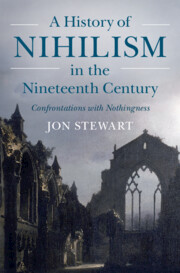Book contents
- A History of Nihilism in the Nineteenth Century
- A History of Nihilism in the Nineteenth Century
- Copyright page
- Dedication
- Contents
- Figures
- Preface
- Acknowledgments
- Introduction
- 1 Jean Paul’s Vision of Nihilism and Plea for the Doctrine of Immortality
- 2 Klingemann and the Absurdity of Nothingness in The Nightwatches
- 3 Nihilism in English Romanticism
- 4 Schopenhauer’s Theory of Human Suffering and Lack of Meaning
- 5 Büchner’s Account of the Reign of Terror as a Mirror of Human Existence
- 6 Poul Martin Møller’s Criticism of Hegelianism and the Danish Discussion of Nihilism
- 7 Kierkegaard and the Indefinability and Inexplicability of Death
- 8 Turgenev’s Portrait of a Nihilist
- 9 Nietzsche’s Vision of the Past and the Future of Nihilism
- 10 The Importance of Nihilism in the Nineteenth Century
- Selected Bibliography on Nihilism
- Name Index
- Subject Index
5 - Büchner’s Account of the Reign of Terror as a Mirror of Human Existence
Published online by Cambridge University Press: 10 March 2023
- A History of Nihilism in the Nineteenth Century
- A History of Nihilism in the Nineteenth Century
- Copyright page
- Dedication
- Contents
- Figures
- Preface
- Acknowledgments
- Introduction
- 1 Jean Paul’s Vision of Nihilism and Plea for the Doctrine of Immortality
- 2 Klingemann and the Absurdity of Nothingness in The Nightwatches
- 3 Nihilism in English Romanticism
- 4 Schopenhauer’s Theory of Human Suffering and Lack of Meaning
- 5 Büchner’s Account of the Reign of Terror as a Mirror of Human Existence
- 6 Poul Martin Møller’s Criticism of Hegelianism and the Danish Discussion of Nihilism
- 7 Kierkegaard and the Indefinability and Inexplicability of Death
- 8 Turgenev’s Portrait of a Nihilist
- 9 Nietzsche’s Vision of the Past and the Future of Nihilism
- 10 The Importance of Nihilism in the Nineteenth Century
- Selected Bibliography on Nihilism
- Name Index
- Subject Index
Summary
Chapter 5 is dedicated to a reading of the drama by Georg Büchner entitled Danton’s Death. The work concerns the trial and execution of the French revolutionary Georges Danton and his comrades. By choosing the French Revolution as his background, Büchner sets the stage for a questioning of the meaning of human existence. The reader knows from the start that most of the main characters in the piece will end up on the guillotine. It is a cruel and inhuman world, where love and friendship play little role. The threat of death is everywhere, and suicide is a frequent theme. Danton represents a voice of nihilism. He despairs of the lack of meaning of human existence and even meets his death with a kind of indifference or even relief. He claims that since we will all die sooner or later, it does not really matter when it happens. The immediate situation of the prisoners awaiting their execution can be regarded as a metaphor for human life in general. Once we are born, we are all destined for death. There is no sign of redemption, reconciliation, or a peace in an afterlife. Death and life are equally meaningless. The world is a cruel and inhuman place, where we suffer merely to survive.
Keywords
- Type
- Chapter
- Information
- A History of Nihilism in the Nineteenth CenturyConfrontations with Nothingness, pp. 149 - 172Publisher: Cambridge University PressPrint publication year: 2023

